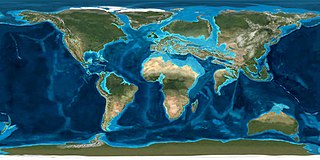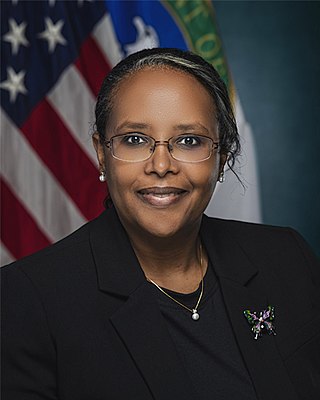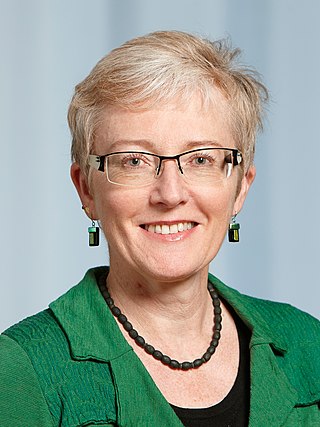Related Research Articles

The Eocene Epoch is a geological epoch that lasted from about 56 to 33.9 million years ago (Ma). It is the second epoch of the Paleogene Period in the modern Cenozoic Era. The name Eocene comes from the Ancient Greek ἠώς and καινός and refers to the "dawn" of modern ('new') fauna that appeared during the epoch.

The carbon cycle is that part of the biogeochemical cycle by which carbon is exchanged among the biosphere, pedosphere, geosphere, hydrosphere, and atmosphere of Earth. Other major biogeochemical cycles include the nitrogen cycle and the water cycle. Carbon is the main component of biological compounds as well as a major component of many minerals such as limestone. The carbon cycle comprises a sequence of events that are key to making Earth capable of sustaining life. It describes the movement of carbon as it is recycled and reused throughout the biosphere, as well as long-term processes of carbon sequestration (storage) to and release from carbon sinks.

Biogeochemistry is the scientific discipline that involves the study of the chemical, physical, geological, and biological processes and reactions that govern the composition of the natural environment. In particular, biogeochemistry is the study of biogeochemical cycles, the cycles of chemical elements such as carbon and nitrogen, and their interactions with and incorporation into living things transported through earth scale biological systems in space and time. The field focuses on chemical cycles which are either driven by or influence biological activity. Particular emphasis is placed on the study of carbon, nitrogen, sulfur, iron, and phosphorus cycles. Biogeochemistry is a systems science closely related to systems ecology.
Mass-independent isotope fractionation or Non-mass-dependent fractionation (NMD), refers to any chemical or physical process that acts to separate isotopes, where the amount of separation does not scale in proportion with the difference in the masses of the isotopes. Most isotopic fractionations are caused by the effects of the mass of an isotope on atomic or molecular velocities, diffusivities or bond strengths. Mass-independent fractionation processes are less common, occurring mainly in photochemical and spin-forbidden reactions. Observation of mass-independently fractionated materials can therefore be used to trace these types of reactions in nature and in laboratory experiments.
An isotopic signature is a ratio of non-radiogenic 'stable isotopes', stable radiogenic isotopes, or unstable radioactive isotopes of particular elements in an investigated material. The ratios of isotopes in a sample material are measured by isotope-ratio mass spectrometry against an isotopic reference material. This process is called isotope analysis.
Ján Veizer is the Distinguished University Professor (emeritus) of Earth Sciences at the University of Ottawa and Institute for Geology, Mineralogy und Geophysics, of Bochum Ruhr University. He held the NSERC/Noranda/CIFAR Industrial Chair in Earth System Isotope and Environmental Geochemistry until 2004. He is an isotope geochemist; his research interests have included the use of chemical and isotopic techniques in determining Earth's climatic and environmental history.

The Cretaceous Thermal Maximum (CTM), also known as Cretaceous Thermal Optimum, was a period of climatic warming that reached its peak approximately 90 million years ago (90 Ma) during the Turonian age of the Late Cretaceous epoch. The CTM is notable for its dramatic increase in global temperatures characterized by high carbon dioxide levels.
Greenhouse gas emissions from wetlands of concern consist primarily of methane and nitrous oxide emissions. Wetlands are the largest natural source of atmospheric methane in the world, and are therefore a major area of concern with respect to climate change. Wetlands account for approximately 20 - 30% of atmospheric methane through emissions from soils and plants, and contribute an approximate average of 161 Tg of methane to the atmosphere per year.
The atmospheric carbon cycle accounts for the exchange of gaseous carbon compounds, primarily carbon dioxide, between Earth's atmosphere, the oceans, and the terrestrial biosphere. It is one of the faster components of the planet's overall carbon cycle, supporting the exchange of more than 200 billion tons of carbon in and out of the atmosphere throughout the course of each year. Atmospheric concentrations of CO2 remain stable over longer timescales only when there exists a balance between these two flows. Methane, Carbon monoxide (CO), and other man-made compounds are present in smaller concentrations and are also part of the atmospheric carbon cycle.

Susan E. Trumbore is an earth systems scientist focusing on the carbon cycle and its effects on climate. She is a director at the Max Planck Institute for Biogeochemistry and a Professor of Earth System Science at University of California, Irvine. She is a fellow of the American Geophysical Union and the American Association for the Advancement of Science, a Member of the National Academy of Sciences and recipient of the Benjamin Franklin Medal.

Asmeret Asefaw Berhe is a soil biogeochemist and political ecologist who is the current Director of the Office of Science at the US Department of Energy. She was previously the Professor of Soil Biogeochemistry and the Ted and Jan Falasco Chair in Earth Sciences and Geology in the Department of Life and Environmental Sciences; University of California, Merced. Her research group worked to understand how soil helps regulate the earth's climate.
Lisa Welp is a biogeochemist who utilizes stable isotopes to understand how water and carbon dioxide are exchanged between the land and atmosphere. She is a professor at Purdue University in the department of Earth, Atmosphere, and Planetary Sciences.
The silica cycle is the biogeochemical cycle in which biogenic silica is transported between the Earth's systems. Silicon is considered a bioessential element and is one of the most abundant elements on Earth. The silica cycle has significant overlap with the carbon cycle and plays an important role in the sequestration of carbon through continental weathering, biogenic export and burial as oozes on geologic timescales.
Adina Paytan is a research professor at the Institute of Marine Sciences at the University of California, Santa Cruz. known for research into biogeochemical cycling in the present and the past. She has over 270 scientific publications in journals such as Science, Nature, Proceedings of the National Academy of Sciences, and Geophysical Research Letters.
Kristie Ann Boering is a Professor of Earth and Planetary Science and the Lieselotte and David Templeton Professor of Chemistry at University of California, Berkeley. She studies atmospheric chemistry and mass transport in the extraterrestrial atmosphere using kinetics and photochemistry. Boering was elected a member of the National Academy of Sciences in 2018.
Sulfur isotope biogeochemistry is the study of the distribution of sulfur isotopes in biological and geological materials. In addition to its common isotope, 32S, sulfur has three rare stable isotopes: 34S, 36S, and 33S. The distribution of these isotopes in the environment is controlled by many biochemical and physical processes, including biological metabolisms, mineral formation processes, and atmospheric chemistry. Measuring the abundance of sulfur stable isotopes in natural materials, like bacterial cultures, minerals, or seawater, can reveal information about these processes both in the modern environment and over Earth history.
Margaret Torn is an ecologist at Lawrence Berkeley National Laboratory known for her research on carbon cycling, especially with respect to the interactions between soils and the atmosphere.
Jennifer Harden is geologist known for her research on soils, particularly tracking changes in soil profiles over time and the role of soil systems in carbon and nitrogen cycling.
Carol Kendall is a hydrologist known for her research tracking nutrients and contaminants in aquatic ecosystems using isotopic tracers.

Nina Buchmann is a German ecologist known for her research on the physiology of plants and the impact of plants on biogeochemical cycling. She is a member of the German National Academy of Sciences Leopoldina and an elected fellow of the American Geophysical Union.
References
- ↑ "Ronald Amundson". Science Societies. Retrieved December 27, 2017.
- ↑ "Ronald Amundson". Our environment: People. University of California, Berkeley. Retrieved December 27, 2017.
- ↑ Amundson, Ronald Gene (1984). A chronosequential evaluation of the effects of reclamation on a saline-sodic soil (Ph.D.). University of California, Riverside. OCLC 10829036 – via ProQuest.
- ↑ "Ronald Amundson". Vice-Chancellor Research. University of California, Berkeley. Retrieved December 27, 2017.
- ↑ Trumbore, Susan E.; Chadwick, Oliver A.; Amundson, Ronald (April 19, 1996). "Rapid Exchange between Soil Carbon and Atmospheric Carbon Dioxide Driven by Temperature Change". Science . 272 (5260): 393–396. Bibcode:1996Sci...272..393T. doi:10.1126/science.272.5260.393. S2CID 54826705.
- ↑ "Ronald Amundson". Google Scholar . Retrieved December 27, 2017.
- ↑ Bell, Robin; Holmes, Mary Anne (August 15, 2019). "2019 Class of AGU Fellows Announced". Eos. 100. doi: 10.1029/2019eo131029 . Retrieved 2020-06-18.